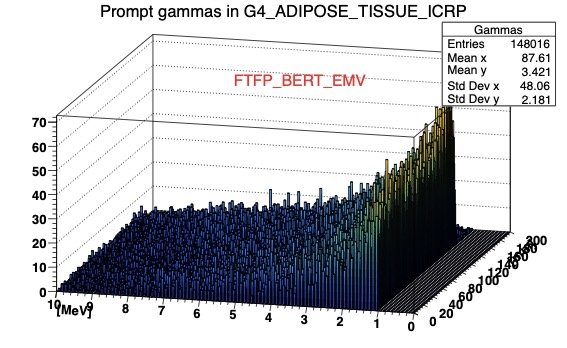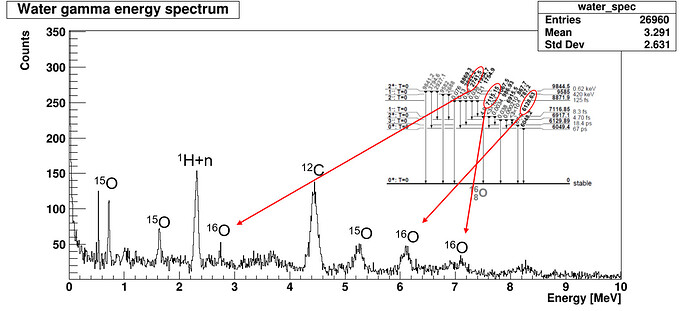Dear all,
Since I’m a beginner in hadron simulation I have tried to do some tests with the Hadr03 example.
The problem I would like to study is quite simple: determine the isotope production rates when a monochromatic proton beam of 20 MeV interacts with pure 18O, but the problem is not really relevant to my question.
I modified only the following lines of mac file of the example to set the target composition and primary particle properties with the hadElastic process active.
/testhadr/det/setIsotopeMat O 8 18 1 g/cm3
/gun/particle proton
/gun/energy 20 MeV
/process/activate hadElastic
I run the example with 1 M primary particle switching to different hadronic physics lists in the PhysicsList class: FTFP_BERT_HP, QGSP_BERT, QGSP_BIC, FTF_BIC.
Here is my question:
I have observed that the yield of particles produced (and also the energy) is very different when the “BERT” or the “BIC” model is used:
BERT output:
List of generated particles:
B11: 22 Emean = 2.749 MeV ( 571.54 keV → 6.3567 MeV)
C12: 218 Emean = 2.3697 MeV ( 72.483 keV → 5.9657 MeV)
C13: 2 Emean = 2.1422 MeV ( 1.7018 MeV → 2.5825 MeV)
C14: 1362 Emean = 2.3995 MeV ( 5.8483 keV → 6.8302 MeV)
F17: 184 Emean = 1.2408 MeV ( 84.233 keV → 2.9278 MeV)
F18: 1145 Emean = 1.3029 MeV ( 38.533 keV → 3.5653 MeV)
N14: 1341 Emean = 2.5116 MeV ( 48.403 keV → 6.5196 MeV)
N15: 664 Emean = 4.1032 MeV ( 453.49 keV → 9.0303 MeV)
N17: 1 Emean = 281.42 keV ( 281.42 keV → 281.42 keV)
O16: 4535 Emean = 1.3871 MeV ( 14.094 keV → 5.875 MeV)
O17: 5860 Emean = 1.276 MeV ( 7.7884 keV → 4.0886 MeV)
O18: 38722 Emean = 636.57 keV ( 8.3534 eV → 4.0469 MeV)
alpha: 3631 Emean = 7.0502 MeV ( 1.1076 MeV → 21.77 MeV)
deuteron: 1516 Emean = 3.8599 MeV ( 773.93 keV → 12.512 MeV)
gamma: 33426 Emean = 1.4499 MeV ( 19.224 keV → 11.335 MeV)
neutron: 14798 Emean = 3.1475 MeV ( 3.4228 keV → 16.305 MeV)
proton: 11633 Emean = 6.3368 MeV ( 253.92 keV → 18.755 MeV)
triton: 954 Emean = 5.2002 MeV ( 648.68 keV → 14.549 MeV)
BIC output:
List of generated particles:
B11: 1007 Emean = 3.0776 MeV ( 43.09 keV → 8.8192 MeV)
C12: 1020 Emean = 2.4898 MeV ( 943.9 eV → 6.2406 MeV)
C13: 297 Emean = 2.0035 MeV ( 112.68 keV → 4.5805 MeV)
C14: 446 Emean = 2.6509 MeV ( 13.864 keV → 7.1889 MeV)
F17: 30 Emean = 1.0983 MeV ( 230.15 keV → 1.9956 MeV)
F18: 715 Emean = 1.6782 MeV ( 36.196 keV → 3.7512 MeV)
He3: 5 Emean = 2.7647 MeV ( 1.5147 MeV → 4.2225 MeV)
Li6: 254 Emean = 3.0887 MeV ( 673.9 keV → 6.2305 MeV)
N14: 6233 Emean = 2.2145 MeV ( 10.274 keV → 6.925 MeV)
N15: 646 Emean = 3.9146 MeV ( 418.15 keV → 8.3915 MeV)
N16[120.420]: 5 Emean = 1.6021 MeV ( 235.23 keV → 2.105 MeV)
O16: 362 Emean = 1.4339 MeV ( 39.167 keV → 4.4528 MeV)
O17: 5309 Emean = 1.6906 MeV ( 7.0063 keV → 4.6191 MeV)
O18: 37986 Emean = 640.44 keV ( 8.3534 eV → 4.0469 MeV)
alpha: 9570 Emean = 5.4259 MeV ( 331.55 keV → 18.779 MeV)
deuteron: 3870 Emean = 7.6367 MeV ( 581.95 keV → 13.954 MeV)
gamma: 22952 Emean = 2.799 MeV ( 52.511 eV → 11.656 MeV)
neutron: 8906 Emean = 3.9191 MeV ( 9.1201 keV → 16.704 MeV)
proton: 3524 Emean = 7.003 MeV ( 840.76 keV → 19.378 MeV)
triton: 342 Emean = 3.6162 MeV ( 493.93 keV → 8.4504 MeV)
Is that right or am I doing something wrong?
In this energy range shouldn’t the two models provide similar cross-sections?
Additionally, if I turn the EM process ON, the number of particles produced changes a lot with high dependence on the particular EM physics list (I have tried the standard and option4, with a factor of 2 in the production yield).
I have attached a txt file with the output of the all tests.
Since in EM simulations I have never observed such pronounced differences, I’m wondering:
How to choose the physics list if the differences are so pronounced?
Thank you for your help
_Geant4 Version:_11.0.3
_Operating System:_Windows 11
_Compiler/Version:_Visual studio 2022
_CMake Version:_3.22.2
Hadr03.txt (11.8 KB)


